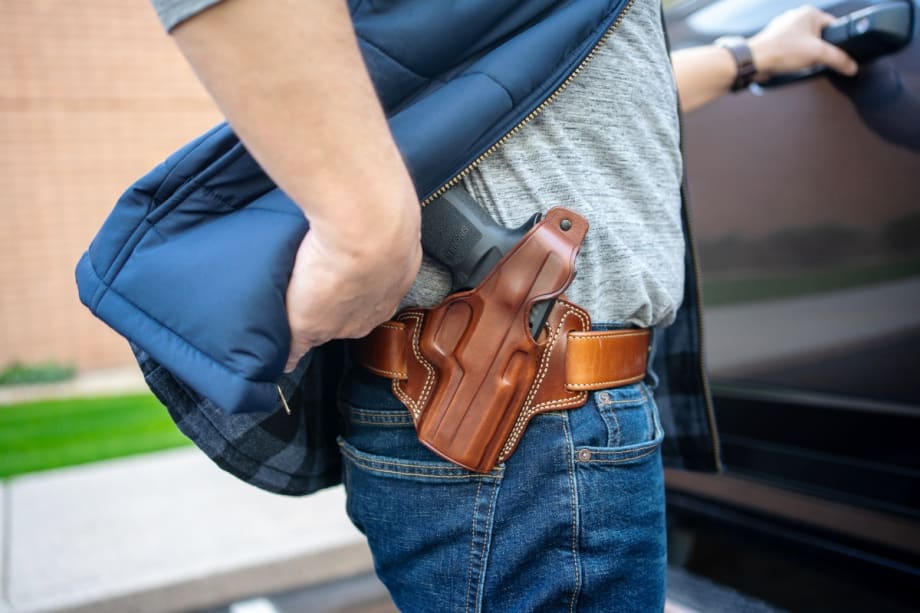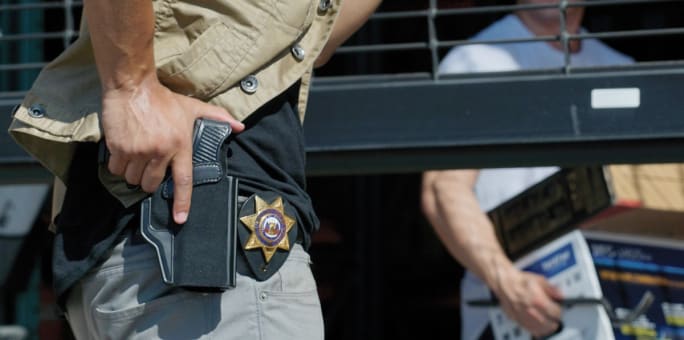Whether working on a plainclothes detail or carrying off duty, selecting the proper holster for concealment and retention is vital. There are many options out there — leather, Kydex, hybrid — but what are the key considerations you should keep in mind?
5 Things to Know When Buying Concealed-Carry or Off-Duty Holsters
Mike Barham, of Galco Holsters, shares five important considerations to keep in mind when you buy off-duty concealed or plain-clothes carry holsters.

A quality off-duty carry holster should enable an easy draw but also provide retention.
PHOTO: Galco Holsters
“Anytime you're carrying a gun, you're carrying it for the defense of yourself or, in a law enforcement context, to protect the community. Anytime you're doing that, you need to have a high-quality high-performance holster whether that's in the duty context, or off duty, or in plainclothes, it applies the same,” says Mike Barham, media and public relations manager for Galco Holsters.
He points out there can be different concealment needs between off-duty officers and civilians, but even for cops, concealment has its advantages.
“The whole gray man philosophy can certainly apply to an off-duty officer, just as much as to a civilian,” he adds.
Barham points to how a quality holster can come into play related to officer safety in the event he or she ever has to draw a weapon while off-duty. An easy and efficient draw is important, but so too is the ability to easily reholster. It is vital to be able to reholster, even one-handed, and not have a weapon in hand when uniformed officers arrive on the scene.
The materials holsters are made from vary, and often individuals will favor one type over another. As Barham points out, it comes down to personal preference.
Kydex, he says, is practically maintenance-free. However, many people find a leather holster more comfortable because it will conform to the shape of one’s body over time. Further, he points out that there are now Kydex-leather hybrid holsters that offer the best of both worlds, the low maintenance of Kydex, and the shape-contouring ability of leather.
“If you look at the inside-the-waistband (IWB) designs that have a Kydex holster pocket and then either a leather or nylon backing plate that's against your body, those tend to conform better to the curvature of your individual body far more than something like Kydex will do,” Barham points out. So Kydex is just sort of the way it is and the way it's always going to be, whereas a lot of people find leather or a hybrid holster more comfortable.”
Of course, Galco for a long time has been known for producing leather holsters, but Barham points out that now the company has a “very strong presence” in both the Kydex and the hybrid holster markets.
So, what officers choose which type off-duty holsters?
“That's a little bit hard to pin down and I think there are some generational considerations there. People who have come into shooting in say the last 10 years, a lot of them have really only known Kydex,” he says while pointing out others are loyal to leather holsters. “Things have just changed and evolved so I think a lot of people just sort of stick with what they're comfortable and familiar with, which probably accounts for a lot of our leather sales.”
Officers know to check with their agencies before buying an off-duty carry firearm to make sure it is approved, but they may also need to check with the department to see if there are any expectations such as having some form of retention, whether a simple strap or otherwise, in an off-duty holster or even a plain-clothes carry holster for duty.

Departments may have required characteristics for a holster work for plain-clothes duty or even off-duty carry.
PHOTO: Galco Holsters
Given his tenure at Galco, Barham knows the ins and outs of all the holster options and provides some suggestions of what you should consider when you are shopping for an off-duty concealed or plain-clothes duty carry holster.
Barham suggests you always consider:
1. Not All Holsters Are Created Equal
There are many quality holsters out there, and there are lots of holsters that can quite literally get you killed Barham says. A holster designed and made in a one-man shop by a guy with two years of shooting experience who has had a CCW for only six months may not be the way to go. A company that outsources holster production to Mexico or Asia may not have the best control over its manufacturing processes and quality control. Look for a company with a long track record and, ideally, American manufacturing and quality control.
2. Cover the Trigger but Not Necessarily the Trigger Guard
The essential goal is that the trigger itself be protected enough that a finger or object can’t be placed on it. Covering more of the trigger guard can quite often be counterproductive. If, for example, the leather or Kydex of the holster is brought back to the “joint” where the trigger guard meets the front strap, a firing grip in the holster becomes impossible. This leads to a requirement to shift the dominant hand’s grip during the draw, which is not only slow but also potentially dangerous.
3. Full Firing Grip
As alluded to above, a firing grip in the holster is critical. Your grip on the gun in the holster should be the same grip you have when the gun is at full extension and ready to fire. Anything less will impede your draw because you’ll need to shift and adjust your grip as you bring the gun on target. This shifting is not only slow but also dangerous because it could cause you to fumble or even drop the handgun. An exception to this rule is made for some body and clothing types, especially for IWB appendix carry, where we might trade a full-firing grip for deeper concealment. Here we’d use a "pinch draw," which is the compression of the thumb and forefinger at the web of the hand. This more advanced technique uses the top of the hand to pull up from the holster, enabling the user to wrap the middle, ring, and pinky fingers around the grip as space is created.
4. Retention Requirements Vary
Open-top, “level one” holsters are often perfectly serviceable for civilian gun carriers. Law enforcement officers, however, are often called upon to go hands-on with suspects, whether in undercover/plainclothes or off-duty contexts. In this scenario, some type of manual retention device may be preferable. In many cases, law enforcement agencies require some kind of retention device, even on plain clothes/off-duty holsters.
5. Proper Wardrobe
You probably don’t wear the same shoes at the gym, in church, to work, and for hiking. It’s the same for holsters. Different seasons, different occasions, and different attire may all call for a change in holsters if you want to remain adequately armed. You might need a belt holster, an IWB, and maybe even an ankle holster for the same gun (or a variant of the same gun). Owning a holster wardrobe allows you to obey the first rule of gunfighting: have a gun.
More Blogposts
Preventing Heat Injury in Police K-9s
In the relentless heat of summer and even early fall in some parts of the country, officers face the important task of protecting their K-9 partners while working in sweltering temperatures. Recognizing changes in a dog’s behavior is the key.
Read More →Why Your Agency Needs to Attend the ILEETA Conference
ILEETA is a complete resource for trainers to address trainers' needs. Its mission is to enhance the skills and safety of criminal justice practitioners while fostering stronger and safer communities.
Read More →IACP 2023: New Training Products
Technologies for improving law enforcement training and training management were some of the highlights at this year's show.
Read More →Initial Results Released from MSP 2024 Police Vehicle Testing
The 2024 pursuit-rated vehicles--all pickup trucks or SUVs, including two battery electric models the Chevrolet Blazer EV AWD and Ford Mustang Mach-E--were put through their paces.
Read More →Officer Safety Considerations Related to Alternative-Fuel Vehicles
As more alternative-fuel and hybrid vehicles hit the road, police and other first responders need to understand that they are no more dangerous than conventional vehicles. However, there are certain safety considerations every cop should know.
Read More →Garmont Working to Grow LE Market Presence
Garmont Tactical has found wide acceptance by military boot buyers, but now the company is trying to better respond to the needs of police officers. Many cops now are not fans of 8-inch boots, so Garmont is adapting.
Read More →Publisher’s Note: Our Commitment to You
Through our magazine and website and our Police Technology eXchange event, we promise to provide you with information and access to resources to help you do your job safer and better.
Read More →10 Tips for Responding to Mental Health Crisis Calls
The Harris County Sheriff's Office is a model for other agencies that want to learn about crisis intervention and mental health crisis response. Sgt. Jose Gomez shares the story of their programs and provides 10 tips for mental health crisis call response
Read More →10 Tips for Reviewing Use-of-Force Reports
While the burden of accurately reporting use-of-force situations is on an individual deputy or officer, the person reviewing those reports shares in the responsibility of making sure the reporting is done properly, with clear details included.
Read More →Small OH Department Launches Digital Forensics Unit
Capt. John Freeman, one of six recipients of the 2022 Magnet Forensics Scholarship Award, will be bringing digital forensics capabilities to his agency, a small Ohio police department of slightly more than 20 sworn officers.
Read More →











